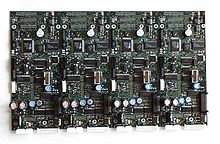- Depanel
-
Depaneling is a process step in high-volume electronics assembly production. In order to increase the throughput of printed circuit board (PCB) manufacturing and surface mount (SMT) lines, PCBs are often designed so that they consist of many smaller individual PCBs that will be used in the final product. This PCB cluster is called a panel or multiblock. The large panel is broken up or "depaneled" as a certain step in the process - depending on the product, it may happen right after SMT process, after in-circuit test (ICT), after soldering of through-hole elements, or even right before the final case-up of the assembly.
Contents
Main depanel technologies
There are five main depaneling cutting techniques currently in use, and a sixth is about to enter the market:
- hand break
- pizza cutter / V-cut
- punch
- router
- saw
- laser (new)
Hand break
This method is suitable for strain-resistant circuits (e.g. without SMD components). The operator simply breaks the PCB, usually along a prepared V-groove line, with the help of a proper fixture.
Pizza cutter / V-cut
A pizza cutter is a rotary blade, sometimes rotating using its own motor. The operator moves a pre-scored PCB along a V-groove line, usually with the help of a special fixture. This method is often used only for cutting huge panels into smaller ones. The equipment is cheap and requires only sharpening of the blade and greasing as maintenance.
Punch
Punching is a process where single PCBs are punched out of the panel through the use of special fixture. It is a two-part fixture, with sharp blades on one part and supports on the other. The production capacity of such a system is high, but fixtures are quite expensive and require regular sharpening.
Router
Depaneling router is a machine similar to wood router. It uses a router bit to mill the material of the PCB. You have to dispose of the bit after some time.
Routing requires that single boards are connected using tabs in a panel. The bit mills the whole material of the tab. It produces much dust that has to be vacuumed. It is important for the vacuum system to be ESD-safe. Also the fixturing of the PCB must be tight - a usually aluminium jig or a vacuum holding system is used.
The two most important parameters of the routing process are: feed rate and rotational speed. They are chosen according to the bit type and diameter and should remain proportional (i.e. increasing feed rate should be done together with increasing the rotational speed).
Routers generate vibrations of the same frequency as their rotational speed (and higher harmonics), which might be important if there are vibration-sensitive components on the surface of the board. The strain level is lower than for other depaneling methods. Their advantage is that they are able to cut arcs and turn at sharp angles. Their disadvantage is lower capacity.
Saw
A saw is able to cut through panels at high feed rates. It can cut both V-grooved and not-V-grooved PCBs. It does not cut much material and therefore generates low amounts of dust.
The disadvantages are: ability to cut in straight lines only and higher stress than for routing.
Laser (as of March, 2010)
UV laser cutting is now being offered as a sixth method by some equipment makers.
External links
- OZO Support, LLC - Custom CNC Router/Drill/Depanel
- SAYAKA High Precision PCB Router
- CENCORP/PMJ automec - router and saw technologies company
- IPTE - company offering electronics manufacturing and test equipment
- Can Today's Depanelers Cut It? - article in Reed Electronics
- Depaneling: a study in yield and productivity: saw systems can provide a low stress and fast alternative to hand breaking methods
- CircuitPeople PCB Panel Calculator
Categories:
Wikimedia Foundation. 2010.

